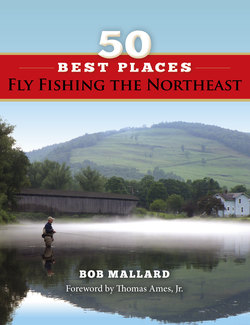Читать книгу 50 Best Places Fly Fishing the Northeast - Bob Mallard - Страница 28
На сайте Литреса книга снята с продажи.
ОглавлениеBob Mallard with spring-caught wild brookie. Libby Camps
Most of the better brook trout lakes and ponds in Maine contain only brook trout and a native minnow or two—usually some sort of dace. This lack of competition allows the brookies to prosper. This also adds to the uniqueness of these waters, as many brook trout ponds found elsewhere in the Northeast have succumbed to the introduction of one or more nonnative gamefish and/or baitfish.
Many of the best brook trout lakes and ponds are restricted to fly fishing only—some to artificial lures only. Many have some sort of a slot limit prohibiting, or restricting, the harvest of large fish. Bag limits are often restricted to just one or two fish per day—and in a few cases they are managed for catch-and-release.
Hatches on Maine’s brook trout ponds start soon after ice-out and continue right into the fall. Mayflies, such as Black Quills and Callibaetis, come first. These are followed
Bob Mallard fishing a remote pond. Thomas Ames, Jr.
by caddis—including Giant Traveling Sedges. Then the often overlooked ants, beetles, dragonflies, and damsels. Next is the Hexagenia—the largest mayfly in the country—and as much an event as it is a hatch. The dry-fly season ends with an early fall midge hatch, which is also overlooked. Fish also feed on the ever-present leeches, minnows, scuds, and in some cases, crayfish. Early and late in the season—and in between hatches—brook trout can be caught by fishing scud, nymph, leech, and streamer patterns below the surface. In fact, this is probably the best way to target large fish—regardless of when, or what is going on at the surface.
The fish in Maine’s brook trout ponds run from 6 to 20 inches. Most are somewhere in between. Ponds have either lots of small fish,
a medium number of mixed-size fish, or a small number of large fish. This does not mean you cannot catch a large fish out of any water at any given time, just that the best way to catch big fish is to target waters that are known to hold big fish. Conversely, if you want lots of fish, head to a pond known for holding many fish.
Time at a traditional Maine sporting camp, with your days spent fishing on remote and undeveloped brook trout ponds, is an experience you will not soon forget. While there, you will likely hear the haunting cries of loons. You may encounter secretive goldeneyes and buffleheads, curious otters, territorial tail-slapping beavers, graceful deer, elusive black bears, and the king of the North Woods—the majestic, albeit ungainly, moose. As for the fish, most anglers will agree that there is nothing more beautiful than a wild Eastern brook trout.
Tackle: A 9-foot 5-weight rod with a floating line is your best bet for fishing dry flies out of a boat on most Maine brook trout ponds. Anything lighter than a 5-weight will make it hard to cast larger flies such as Hexagenia imitations. As for rods shorter than 9 feet, this can make it hard to get the distance sometimes required to target a fish feeding away from the boat. If you plan to fish subsurface, a 9-foot 6-weight with one slow and one fast full-sinking line is your best option. Float tubers may want to consider a 9½- or 10-foot rod with a dry and sinking line as an alternative to carrying two rods—and to help keep your backcast out of the water. Leaders should be 9 to 15 feet and taper to 4X or 5X for dries, and 6 to 7½ feet for wets—with fluorocarbon being your best bet for the latter. Flies should include leech patterns, classic streamers such as Black-
